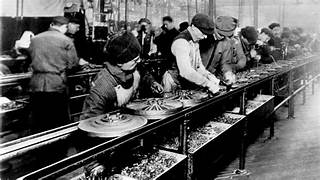Privacy Policy | Terms of Use | Cookie Policy | Disclaimer
Empowering the American middle class — one story at a time.
The Rise of the American Middle Class
The American middle class didn’t simply appear — it was built, generation by generation, on the efforts of workers, veterans, immigrants, and reformers who believed in the promise of a better future. As the United States transformed from a young nation into an industrial power, a new social force emerged that would come to define modern American life: the middle class.
Throughout the late 1800s and early 1900s, industrialization created millions of jobs, while labor unions fought for the rights of workers. These efforts laid the groundwork for economic security and upward mobility. By the mid-20th century, especially after World War II, this movement took full shape. Soldiers returned home and used the GI Bill to buy homes, attend college, and start businesses. New neighborhoods blossomed, public education expanded, and home ownership became the norm—not just the dream—for millions of families.
Wages were strong, jobs were stable, and American manufacturing was at its peak. The middle class became the engine of the American economy—buying homes, cars, and appliances that created even more jobs. Unions protected workers from exploitation, and families had access to pensions, health care, and savings. For the first time in history, ordinary citizens could afford vacations, higher education for their children, and retirement with dignity.
Women also played a vital role. During WWII, they had entered the workforce in large numbers and remained in it afterward. Dual-income households helped increase purchasing power and create new opportunities for families. Meanwhile, civil rights movements pushed for inclusion and equal treatment, helping to slowly expand the benefits of middle-class life to more Americans, regardless of race or background.
Education became a cornerstone of the middle-class promise. Public schools improved, state universities became affordable, and vocational training was widely available. Knowledge was seen as the key to advancement, and entire generations were lifted by access to learning and opportunity. The belief that each child could do better than the last generation was central to middle-class life.
The culture of the middle class influenced everything from politics to television. Shows like "Leave It to Beaver" and "The Brady Bunch" reflected the values of family, hard work, and aspiration. Middle-class Americans became the voters politicians sought to reach, the consumers businesses aimed to please, and the backbone of a strong democracy.
By the 1960s and 70s, the middle class had grown powerful enough to shape the nation’s direction. They pushed for better roads, safer workplaces, clean air and water, and social programs that helped lift more people out of poverty. A growing sense of civic duty and shared responsibility helped unite communities and inspire progress across the country.
Yet the rise of the middle class wasn’t without struggle. Every gain was hard-won—through strikes, protests, legislation, and the courage of everyday people demanding fairness. This era showed that a healthy middle class doesn’t just benefit individuals—it strengthens the entire nation. It brings economic balance, political stability, and hope for the future.
Today, as we face rising costs, job insecurity, and deep inequality, we must look back at the rise of the American middle class and remember what made it possible: unity, hard work, fair wages, access to education, and policies that uplifted working people. That spirit remains at the heart of My Middle Class America. It reminds us that when ordinary people are given real opportunities, they can accomplish extraordinary things—for themselves, their families, and their country.

